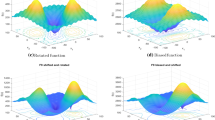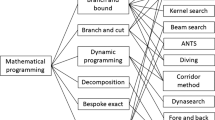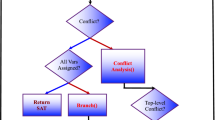Abstract
This paper investigates the necessary features of an effective clause weighting local search algorithm for propositional satisfiability testing. Using the recent history of clause weighting as evidence, we suggest that the best current algorithms have each discovered the same basic framework, that is, to increase weights on false clauses in local minima and then to periodically normalize these weights using a decay mechanism. Within this framework, we identify two basic classes of algorithm according to whether clause weight updates are performed additively or multiplicatively. Using a state-of-the-art multiplicative algorithm (SAPS) and our own pure additive weighting scheme (PAWS), we constructed an experimental study to isolate the effects of multiplicative in comparison to additive weighting, while controlling other key features of the two approaches, namely, the use of pure versus flat random moves, deterministic versus probabilistic weight smoothing and multiple versus single inclusion of literals in the local search neighbourhood. In addition, we examined the effects of adding a threshold feature to multiplicative weighting that makes it indifferent to similar cost moves. As a result of this investigation, we show that additive weighting can outperform multiplicative weighting on a range of difficult problems, while requiring considerably less effort in terms of parameter tuning. Our examination of the differences between SAPS and PAWS suggests that additive weighting does benefit from the random flat move and deterministic smoothing heuristics, whereas multiplicative weighting would benefit from a deterministic/probabilistic smoothing switch parameter that is set according to the problem instance. We further show that adding a threshold to multiplicative weighting produces a general deterioration in performance, contradicting our earlier conjecture that additive weighting has better performance due to having a larger selection of possible moves. This leads us to explain differences in performance as being mainly caused by the greater emphasis of additive weighting on penalizing clauses with relatively less weight.
Similar content being viewed by others
References
Everett, H. (1963) Generalized Lagrange multiplier method for solving problems of the optimal allocation of resources, Oper. Res. 11, 399–417.
Gent, I., Hoos, H., Prosser, P. and Walsh, T. (1999) Morphing: Combining structure and randomness, in Proceedings of the Sixteenth National Conference on Artificial Intelligence (AAAI-99), pp. 654–660.
Gibbons, J. and Chakraborti, S. (1992) Nonparametric Statistical Inference, Statistics: Textbooks and Monographs, Marcel Dekker, Inc., New York, pp. 241–251.
Hoos, H. (2002) An adaptive noise mechanism for WalkSAT, in Proceedings of the Nineteenth National Conference on Artificial Intelligence (AAAI-02), pp. 655–660.
Hoos, H. and Stützle, T. (1998) Evaluating Las Vegas algorithms: Pitfalls and remedies, in Proceedings of the Fourteenth Conference of Uncertainty in Artificial Intelligence (UAI-98), pp. 238–245.
Hoos, H. and Stützle, T. (2005) Stochastic Local Search: Foundations and Applications, Elsevier, New York.
Hutter, F., Tompkins, D. and Hoos, H. (2002) Scaling and probabilistic smoothing: Efficient dynamic local search for SAT, in Proceedings of the Eighth International Conference on the Principles and Practice of Constraint Programming (CP'02), pp. 233–248.
Li, C. and Anbulagan , A. (1997) Look-ahead versus look-back for satisfiability problems, in Proceedings of the Third International Conference on the Principles and Practice of Constraint Programming (CP'97), pp. 341–355.
McAllester, D., Selman, B. and Kautz, H. (1997) Evidence for invariance in local search, in Proceedings of the Fourteenth National Conference on Artificial Intelligence (AAAI-97), pp. 321–326.
Mills, P. and Tsang, E. (1999) Guided local search applied to the satisfiability (SAT) problem, in Proceedings of the Fifteenth National Conference of the Australian Society for Operations Research (ASOR'99), pp. 872–883.
Morris, P. (1993) The Breakout method for escaping local minima, in Proceedings of the Eleventh National Conference on Artificial Intelligence (AAAI-93), pp. 40–45.
Moskewicz, M., Madigan, C., Zhao, Y., Zhang, L. and Malik, S. (2001) Chaff: Engineering an efficient SAT solver, in Proceedings of the Thirty-ninth Design Automation Conference (DAC2001), pp. 530–535.
Prestwich, S. (2003) Local search on SAT-encoded colouring problems, in Proceedings of the Sixth International Conference on Theory and Applications of Satisfiability Testing (SAT-03), pp. 105–119.
Schuurmans, D. and Southey, F. (2000) Local search characteristics of incomplete SAT procedures, in Proceedings of the Seventeenth National Conference on Artificial Intelligence (AAAI-00), pp. 297–302.
Schuurmans, D., Southey, F. and Holte, R. (2001) The exponentiated subgradient algorithm for heuristic Boolean programming, in Proceedings of the Seventeenth International Joint Conference on Artificial Intelligence (IJCAI-01), pp. 334–341.
Shang, Y. and Wah, B. (1998) A discrete Lagrangian-based global search method for solving satisfiability problems, J. Glob. Optim. 12, 61–99.
Thornton, J. and Sattar, A. (1999) On the behaviour and application of constraint weighting, in Proceedings of the Fifth International Conference on the Principles and Practice of Constraint Programming, CP'99, pp. 446–460.
Thornton, J., Pullan, W. and Terry, J. (2002) Towards fewer parameters for clause weighting SAT algorithms, in Proceedings of the Fifteenth Australian Joint Conference on Artificial Intelligence, AI-2002, pp. 569–578.
Thornton, J., Pham, D., Bain, S. and Ferreira Jr., V. (2004) Additive versus multiplicative clause weighting for SAT, in Proceedings of the Nineteenth National Conference on Artificial Intelligence, AAAI-2004, pp. 191–196.
Tompkins, D. and Hoos, H. (2004) Warped landscapes and random acts of SAT solving, in Proceedings of the Eighth International Symposium on Artificial Intelligence and Mathematics, (AI&M-04).
Wu, Z. and Wah, B. (2000) An efficient global-search strategy in discrete Lagrangian methods for solving hard satisfiability problems, in Proceedings of the Seventeenth National Conference on Artificial Intelligence (AAAI-00), pp. 310–315.
Author information
Authors and Affiliations
Corresponding author
Rights and permissions
About this article
Cite this article
Thornton, J. Clause Weighting Local Search for SAT. J Autom Reasoning 35, 97–142 (2005). https://doi.org/10.1007/s10817-005-9010-1
Published:
Issue Date:
DOI: https://doi.org/10.1007/s10817-005-9010-1




